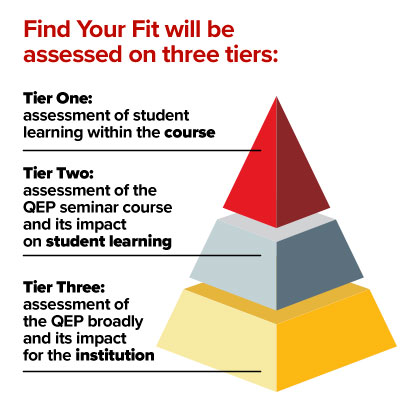
QEP Assessment

As part of the development efforts of Find Your Fit, a three-tiered assessment plan was created to assess the various components of the current QEP, including:
- Assessment of the QEP student learning outcomes, tier one [PDF];
- Assessment of the QEP seminar course and its impact on student learning tier two [PDF]; and
- Assessment of the QEP broadly and its impact on student success tier three [PDF].
A conceptual map [PDF] was created to help articulate key learning and developmental constructs that will be addressed within the QEP. This map also provides a foundation for assessing key student learning outcomes as well as the project at large. A logic model [PDF] for assessing and evaluating the impact of the QEP.
The QEP student learning outcomes are reflected in the logic model under outputs, considered to be the expected outcomes produced by the students within the course environment. The QEP logic model includes key outcomes and impact measures that will be used to assess and evaluate the impact of the QEP. The outcomes include students’ declaration of major, increased persistence into the third year, and successful completion of undergraduate degree program. Our hypothesis for the QEP is “the QEP experience will lead to increased levels of persistence, academic performance and declaration of major.”
Assessment of Student Learning
Tier one assessments focuses on the four student learning outcomes and are measured within the seminar course. The four QEP outcomes are:

The QEP seminar course, ECPY 302, utilizes a signature assignment to assess informed decision-making. Students are asked to complete both an I-Search project and an Academic and Personal Plan that requires students to demonstrate reflective learning, independent inquiry, and critical thinking which is scored using an internally created assessment rubric [pdf]. Students’ sense of belonging, decidedness, and self-regulated learning behavior are measured using a pre- and post-assessment scale [pdf] that utilizes valid and reliable psychometric instruments grounded in student development theory [pdf].
Assessment of the Seminar Course
The QEP utilizes a seminar course experience as the intervention for supporting the QEP’s student learning outcomes. Multiple sections of the QEP course is offered each semester with a unique academic theme led by an instructional team consisting a lead faculty instructor, university librarian, and an academic counselor. Although the academic theme differs from section to section, the course activities and outcomes are the same across sections and semester. At the conclusion of each academic semester, the FYF staff team collects, organizes, and analyzes seminar artifacts such as:
- classroom learning activities,
- reflection journal entries,
- seminar course grades,
- University course evaluations,
- FYF Student Feedback Form [PDF],
- Instructional Team Feedback Form [PDF], and
- Students’ HAT artifacts.
The FYF staff team, along with the instructional teams from each semester, analyzes the data and themes major findings from the semester offering. Based on these findings, recommendations are developed and minor adjustments to the learning experiences are implemented to improve student learning within the seminar environment. Adjustments to the seminar experience, including course assignments and activities, are made annually based on findings from tier one and two assessment efforts.
Assessment of the QEP at the Institutional Level
A logic model was developed to assist in the articulation of the resources, activities, and outputs required for the implementation of the FYF project. Included in the logic model are the anticipated short-term, long-term, and institutional impact that we expect the FYF project to produce. We expect the following short-term outcomes to be accomplished between one to three semesters beyond participating students’ completion of the seminar:
- Students will declare their (suitable) major, which aligns with their academic interests within one semester after successful completion of the QEP course;
- Students will persist at a higher rate into their third year; and
- Instructional team will report increased team functionality.
Both long-term and institutional impact will be evaluated towards the end of the current QEP project. These analyses are dependent upon continued longitudinal tracking of both continuously enrolled students upon successful completion of their undergraduate degree and non-returning students who have left the institution prior to completing their academic program. A QEP assessment report is created annually to share findings of the project to date and will include findings at the institutional level as the project matures. The inaugural assessment report, the Pilot Phase Assessment report [PDF], provides the findings from the two pilot semesters, spring and fall 2018. Subsequent annual assessment reports will report out findings from the immediate academic year as well as an ongoing report out of the project as a whole.

